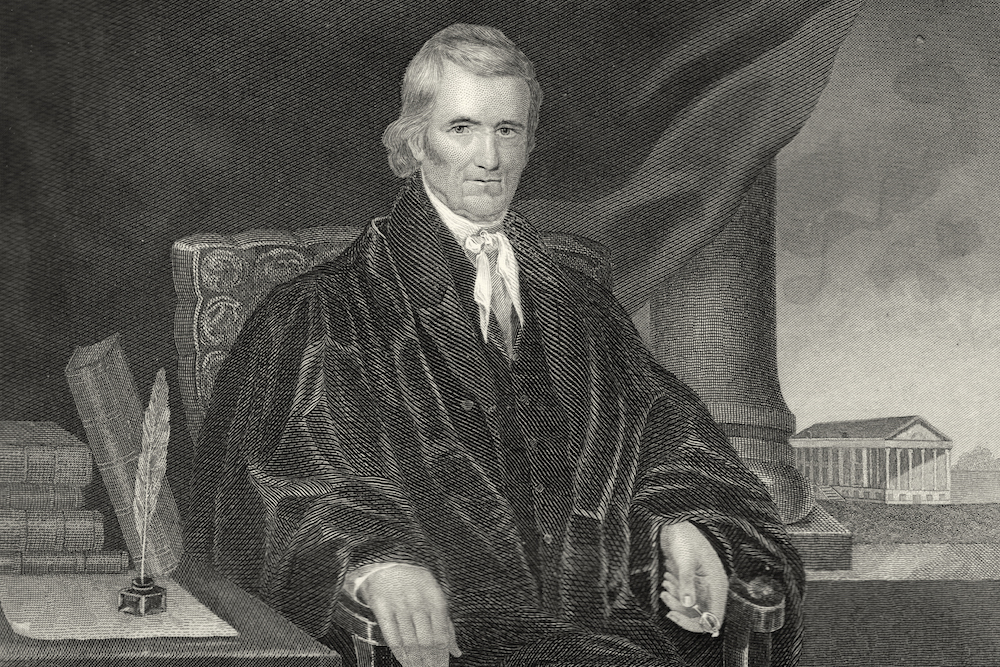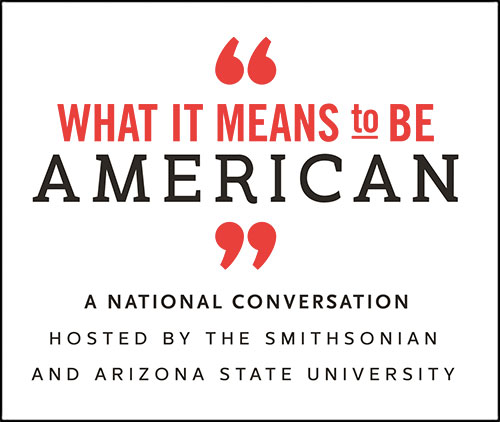
The Court is now in session: Chief Justice John Marshall. Image courtesy of Wikimedia Commons.
 No one in the founding generation left a more lasting imprint on American government and law than Chief Justice John Marshall.
No one in the founding generation left a more lasting imprint on American government and law than Chief Justice John Marshall.
We remember Washington’s leadership, Jefferson’s eloquence, and Franklin’s wit, but Marshall breathed life into the Constitution, elevated the judiciary, and defended the federal government’s power over feuding states. The power of judicial review and the corresponding principle that courts should not interfere with political judgments are just two of the many doctrines that Marshall wove into our Constitution.
How was it possible that a man raised with 14 siblings in a 400-square-foot, two-room log cabin on the hardscrabble western frontier of Virginia defined the Constitution and forged some of the foundational principles of our system of government?
The answer lies in Marshall’s talent for constantly reinventing himself. In scarcely two decades, Marshall rose from a sharpshooter in the Continental Army to become the Judge Advocate General at Valley Forge, the youngest member of the Virginia Council of State, acting attorney general of the Commonwealth, emissary to France, a congressional leader of the Federalist Party, U.S. secretary of state, and chief justice. All of that reinvention nurtured a genius for inventing new legal doctrines.
President John Adams nominated Marshall as chief justice in 1800, after several other men had already turned down the job. In its first decade, the Court had an average of six cases a year and none of genuine importance. Justices spent most of their time riding circuit around the country hearing local disputes argued by untrained lawyers and sharing beds with strangers in rural taverns. Who would want to be chief justice? Of Marshall’s predecessors, John Jay had quit to run for New York Governor, John Rutledge lasted six months, and Oliver Ellsworth resigned after four years.
The Supreme Court was a constitutional afterthought. No one had even bothered to plan for a courthouse in the new capital. When the Marshall Court met for the first time it was assigned to a cramped nondescript committee room on the first floor of the Capitol, which it had to share with the federal district court and the court of appeals.
As Chief Justice, Marshall transformed the Supreme Court into a co-equal branch of the federal government by insisting the Court issue one unified opinion rather than having each justice issue his own opinion, as was the custom. During his 34 years on the Court, Marshall participated in more than 1,100 decisions, more than half of which he wrote, and all but 36 of his opinions were unanimous.
What makes this record all the more remarkable is that every justice appointed to the Court to serve alongside Marshall was appointed by a Republican president hostile to Marshall’s philosophy. Yet Marshall’s personality and intellect won over his brethren despite their opposing ideologies. Marshall achieved this level of unanimity in part by arranging for the justices to live together as a fraternity in the same rooming house. They literally ate every meal together as they reasoned through their docket.
The Marshall Court faced so many questions of first impression—cases involving the reach of federal powers and the checks and balances between the federal branches, the rights of aliens and Indians, corporations and colleges, and state sovereignty. Without the guidance of past precedence Marshall had to adjudicate these novel situations, and in the process he invented much of the constitutional and international law we have today.
One example of Marshall’s creativity concerned a dispute between two claimants to land in Florida. James Foster and Pleasants Elam purchased land in Florida while it was still owned by Spain. In 1819 Spain transferred Florida to the United States under the Transcontinental Treaty, which expressly guaranteed that the United States would recognize all pre-existing land grants made by Spain. Seven years later Foster and Elam discovered David Neilson squatting on their land, and they sued him for trespass. Neilson argued that despite their Spanish title they had no legal right to the land, and the case ended up in the Supreme Court. The Constitution provides that treaties are “the supreme law of the land,” and so it seemed that Foster and Elam would be the rightful owners.
Nevertheless, Marshall issued a unanimous opinion that denied Foster and Elam their property rights despite the treaty with Spain. Marshall reasoned that not all treaties were equal under the Constitution. Some treaties were intended to have a direct effect on domestic law, while others required implementing legislation from Congress. In Marshall’s view, the Transcontinental Treaty was not intended to be “self-executing,” and since Congress had done nothing to reaffirm the property rights granted by Spain, those rights could not be recognized in a U.S. court.
Why would Marshall, a stalwart defender of property rights, concede the rights of a prior owner in this situation? One explanation is that Marshall knew that then-President Andrew Jackson had no intention of complying with the treaties negotiated with tribal nations. Most probably, Marshall reasoned that by giving the courts some leeway to decide the status of these treaties the Court could avoid a direct confrontation with Jackson. Though Marshall subsequently affirmed the rights of tribal nations in a famous decision, Worcester v. Georgia, he did so when he could command a consensus on the Court, and when he thought that case presented the best opportunity for defending Indian sovereignty.
The case of Foster & Elam v. Neilson continues to stand for the proposition that there are self-executing and non-self-executing treaties and that it is up to courts to determine whether a specific treaty has a direct effect on legal rights under our law. Though Marshall attributed this principle to customary international law, in fact, it was pure invention.
Chief Justice Marshall was a pragmatist. Though he could best be described as a progressive today, he was not an ideologue. He insisted on unanimity wherever possible and worked hard at forging a consensus on the Supreme Court. He opposed slavery, but he knew that was a longer fight, and so he pushed his colleagues toward strengthening the power of the federal government over the states in the hopes that someday Congress would regulate slavery out of existence.
Marshall had a lasting imprint on the Supreme Court and the Constitution because he sought pragmatic solutions and valued consensus. That’s what democracy requires: practical jurists and statesmen who prefer compromise to chaos.




Send A Letter To the Editors